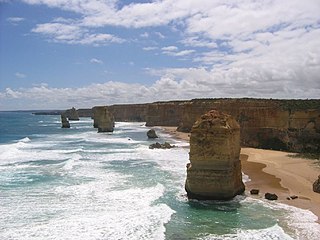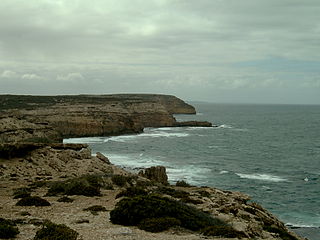Related Research Articles
This article describes the history of the Australian colony and state of Victoria.

George Augustus Robinson was a British builder and untrained preacher. He was the Chief Protector of Aborigines in Port Phillip District, from 1839 to 1849. Prior to this appointment by the Colonial Office in Great Britain, he had been called upon to mount a "friendly mission" to find the 300 remaining Aboriginals in Tasmania.

The Western District comprises western regions of the Australian state of Victoria. It is said to be an ill–defined district, sometimes incorrectly referred to as an economic region,. The district is located within parts of the Barwon South West and the Grampians regions; extending from the south-west corner of the state to Ballarat in the east and as far north as Ararat. The district is bounded by the Wimmera district in the north, by the Goldfields district in the east, by Bass Strait and the Southern Ocean in the south, and by the South Australian border in the west. The district is well known for the production of wool. The most populated city in the Western District is the Ballarat region, with 96,940 inhabitants.

The Bass River, a perennial river of the Western Port catchment, is located in the West Gippsland region of the Australian state of Victoria.
Wathaurong, also called the Wathaurung and Wadawurrung, are an Indigenous Australian tribe living in the area near Melbourne, Geelong and the Bellarine Peninsula. They are part of the Kulin alliance. The Wathaurung language was spoken by 25 clans south of the Werribee River and the Bellarine Peninsula to Streatham. They were sometimes referred to by Europeans as the Barrabool people. The area they inhabit has been occupied for at least the last 25,000 years, with 140 archaeological sites having been found in the region, indicating significant activity over that period.
The Cadigal, also spelled as Gadigal and Caddiegal, are a group of indigenous Australians whose traditional lands are located in Sydney, New South Wales, Australia. The Cadigal originally inhabited the area that they called "Cadi" that lies south of Port Jackson covering today's Sydney central business district and stretches from South Head to Petersham with part of the southern boundary lying on the Cooks River.
The office of the Protector of Aborigines was established pursuant to a recommendation contained in the Report of the Parliamentary Select Committee on Aboriginal Tribes, of the House of Commons. On 31 January 1838, Lord Glenelg, Secretary of State for War and the Colonies sent Governor Gipps the report.
The following lists events that happened during 1838 in Australia.
The Dhauwurd Wurrung, also known as the Gunditjmara, are an Indigenous Australian people of southwestern Victoria. They are the traditional owners of the areas now encompassing Warrnambool, Port Fairy, Woolsthorpe and Portland.

Australian native police units, consisting of Aboriginal troopers under the command usually of a single white officer, existed in various forms in all Australian mainland colonies during the nineteenth and, in some cases, into the twentieth centuries. The Native Police were utilised as a cost effective and brutal paramilitary instrument in the expansion and protection of the British colonial frontier in Australia. Mounted Aboriginal troopers of the Native Police, armed with rifles, carbines and swords escorted surveying groups, pastoralists and prospectors into frontier areas. They would usually then establish base camps and patrol these areas to enforce warrants, conduct punitive missions against resisting local aboriginal groups, and fulfil various other duties. To maintain the imperial British method of "divide and conquer" and to reduce desertions, the aboriginals within the Native Police were routinely recruited from areas that were very distant from the frontier places in which they were deployed. As the troopers were Aboriginal, this benefited the colonists by minimising both the wages of the police and the potential for aboriginal revenge attacks against white people. It also increased the efficiency of the force as the Aboriginal troopers were vastly superior in their ability to track down dissidents in often poorly charted and difficult terrain.

The Australian frontier wars is a term applied by some historians to violent conflicts between Indigenous Australians and white settlers during the British colonisation of Australia. The first fighting took place several months after the landing of the First Fleet in January 1788 and the last clashes occurred in the early 20th century, as late as 1934. A minimum of 40,000 Indigenous Australians and between 2,000 and 2,500 settlers died in the wars. However, recent scholarship on the frontier wars in what is now the state of Queensland indicates that Indigenous fatalities may have been significantly higher. Indeed, while battles and massacres occurred in a number of locations across Australia, they were particularly bloody in Queensland, owing to its comparatively larger pre-contact Indigenous population.

Aboriginal Victorians, the indigenous Australians of Victoria, Australia, occupied the land for tens of thousands of years prior to European settlement. Aboriginal people have lived a semi-nomadic existence of fishing, hunting and gathering, and farming eels in Victoria for at least 40,000 years.
Ian D. Clark is an academic historian and Toponymist whose primary work has focused on Victorian Aboriginal history, aboriginal toponymy and the frontier conflict between Indigenous Australians and immigrant settlers during the European settlement of Victoria, Australia.
The Rufus River Massacre was a massacre of Aboriginals that took place in 1841 along the Rufus River near Wentworth, Australia. It was the result of six months of guerrilla warfare by the local Aboriginal people (Maraura), who blocked an overlander route through their land. The original cause of much of the trouble with the Aboriginal groups was the Europeans engaging in sexual relations with the women without giving the food and clothing promised first. That initiated an escalating cycle of conflicts, which eventually included the Aboriginal groups stealing thousands of European sheep.

Tunnerminnerwait (c.1812–1842) was an Australian aboriginal resistance fighter and Parperloihener clansman from Tasmania. He was also known by several other names including Peevay, Jack of Cape Grim, Tunninerpareway and renamed Jack Napoleon Tarraparrura by George Robinson.

The Waterloo Bay massacre, also known as the Elliston massacre, was a clash between European settlers and Aboriginal Australians that took place on the cliffs of Waterloo Bay near Elliston, South Australia in late May 1849. Part of the Australian frontier wars, the most recent scholarship indicates that it is likely that it resulted in the deaths of tens or scores of Aboriginal people. The events leading up to the fatal clash included killings of three European settlers by Aboriginal people, and the killing of one Aboriginal person and the death by poisoning of five others by European settlers. The limited archival records indicate that three Aboriginal people were killed or died of wounds from the clash, and five were captured, although accounts of the killing of up to 260 Aboriginal people at the cliffs have circulated since at least 1880.
The British colony of New South Wales was expanding rapidly in the late 1830s. Settlers with large herds of sheep and cattle were pushing beyond the official limits of location into the grasslands that had been maintained for thousands of years through Aboriginal firestick farming. Conflict with resident Aboriginals and disputes between the pastoralists in these frontier areas forced the Government of New South Wales in 1839 to legislate for a new paramilitary policing body that would control these issues. This force was called the Border Police.
Criminal activity in New South Wales, Australia is combated by the New South Wales Police Force and the New South Wales court system, while statistics about crime are managed by the NSW Bureau of Crime Statistics and Research. Modern Australian states and cities, including New South Wales, have some of the lowest crime rates recorded globally with Australia ranked the 13th safest nation and Sydney ranked the 5th safest city globally. As of September 2018 the City of Sydney had the highest rate of violent crime per 100,000 people (1445.1), followed by City of Penrith (475.7) and City of Blacktown (495.1). Rural areas have comparatively high crime rates per 100,000 with rural shires such as Walgett Shire (1350.3) and Moree Plains Shire (1236.2) having some of the highest violent crime rates in the state. The overall NSW crime rate has been in steady decline for many years.
References
- ↑ "Aboriginal history timeline (1770 - 1899)", Creative Spirits accessed 25 February 2014
- ↑ "'Aboriginal wars' memorial plan under fire", News.com.au 8 June 2008 accessed 25 February 2014